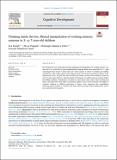Files in this item
Thinking inside the box : mental manipulation of working memory contents in 3- to 7-year-old children
Item metadata
| dc.contributor.author | Reindl, Eva | |
| dc.contributor.author | Parkash, Divya | |
| dc.contributor.author | Voelter, Christoph Johannes | |
| dc.contributor.author | Seed, Amanda Madeleine | |
| dc.date.accessioned | 2021-05-28T14:30:17Z | |
| dc.date.available | 2021-05-28T14:30:17Z | |
| dc.date.issued | 2021-07 | |
| dc.identifier | 274399617 | |
| dc.identifier | ceefe212-e554-4990-a34b-bcd2e51b81cf | |
| dc.identifier | 85106643247 | |
| dc.identifier | 000685650700013 | |
| dc.identifier.citation | Reindl , E , Parkash , D , Voelter , C J & Seed , A M 2021 , ' Thinking inside the box : mental manipulation of working memory contents in 3- to 7-year-old children ' , Cognitive Development , vol. 59 , 101068 . https://doi.org/10.1016/j.cogdev.2021.101068 | en |
| dc.identifier.issn | 0885-2014 | |
| dc.identifier.other | ORCID: /0000-0002-3867-3003/work/94669200 | |
| dc.identifier.uri | https://hdl.handle.net/10023/23270 | |
| dc.description | This work was supported by a European Research Council (ERC) starting grant awarded to A.M.S. (INQMINDS, no. SEP-210159400). | en |
| dc.description.abstract | We developed a non-verbal task assessing updating and manipulation of working memory contents. 80 3- to 7-year-olds (47 girls; predominantly European White) were tested with a 4 × 4 grid containing 8 boxes (in the 4 centre cells and 4 outer corners). A sticker was hidden and children searched for it after a delay phase. In the updating trials, the grid was rotated during delays, in the manipulation trials, the grid was both occluded and rotated. Rewards were hidden in either the inner or outer boxes (between-subjects design). Performance was affected by age, rotation degree and hiding condition. Performance was better in outer boxes trials, where visual tracking was easier. Occluded inner trials added a substantial cognitive load (which increased with degree of rotation), resulting in children performing at chance level, suggesting that manipulation involving mental rotation is a distinct skill from tracking invisible object displacement, with a more protracted development. | |
| dc.format.extent | 13 | |
| dc.format.extent | 2105823 | |
| dc.language.iso | eng | |
| dc.relation.ispartof | Cognitive Development | en |
| dc.subject | Working memory | en |
| dc.subject | Mental manipulation | en |
| dc.subject | Mental rotation | en |
| dc.subject | Executive functions | en |
| dc.subject | Updating | en |
| dc.subject | RC0321 Neuroscience. Biological psychiatry. Neuropsychiatry | en |
| dc.subject | DAS | en |
| dc.subject.lcc | RC0321 | en |
| dc.title | Thinking inside the box : mental manipulation of working memory contents in 3- to 7-year-old children | en |
| dc.type | Journal article | en |
| dc.contributor.sponsor | European Research Council | en |
| dc.contributor.institution | University of St Andrews. School of Psychology and Neuroscience | en |
| dc.contributor.institution | University of St Andrews. ‘Living Links to Human Evolution’ Research Centre | en |
| dc.contributor.institution | University of St Andrews. Centre for Social Learning & Cognitive Evolution | en |
| dc.contributor.institution | University of St Andrews. Institute of Behavioural and Neural Sciences | en |
| dc.identifier.doi | https://doi.org/10.1016/j.cogdev.2021.101068 | |
| dc.description.status | Peer reviewed | en |
| dc.identifier.url | https://www.sciencedirect.com/science/article/pii/S0885201421000630#sec0075 | en |
| dc.identifier.grantnumber | 639072 | en |
This item appears in the following Collection(s)
Items in the St Andrews Research Repository are protected by copyright, with all rights reserved, unless otherwise indicated.

